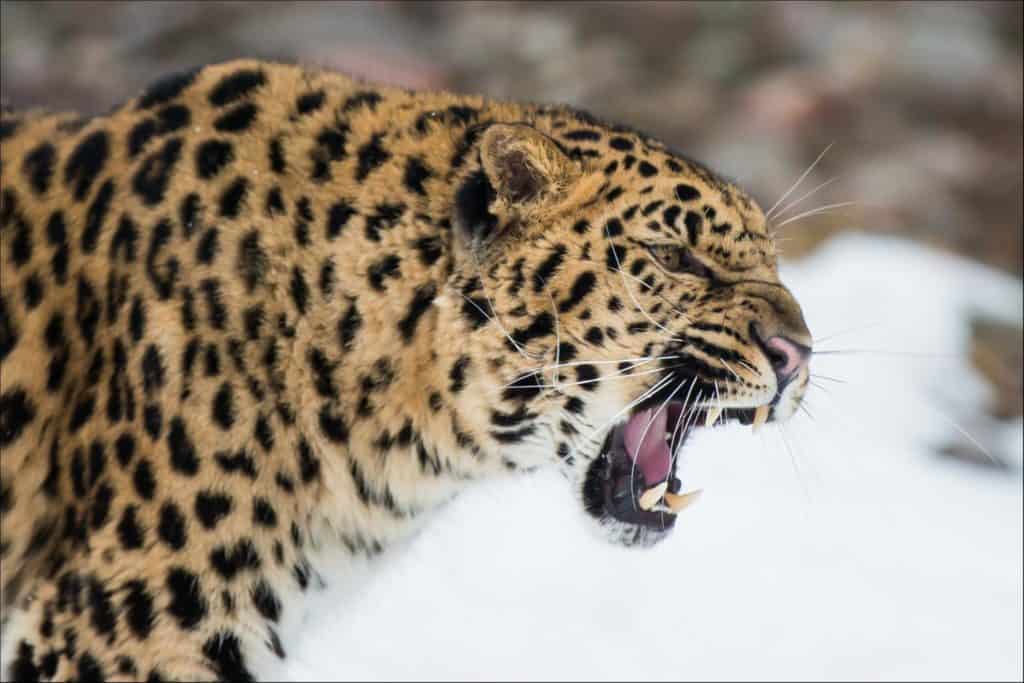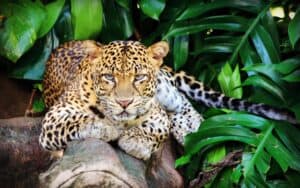The stunning Amur leopard is almost certainly the world’s rarest big cat. Their scientific name is Panthera pardus orientalis, making them a subspecies of leopard that, from 2017, has included the former subspecies P. p. japonensis. These two animals are, however, still considered as separate management units by conservation organizations and they need all the help they can get! They get their name from Amur Bay in the far east of Russia, although they are also called Siberian leopards, Far Eastern leopards, and Korean leopards.
You are highly unlikely to ever see one of these creatures in the wild because there are so few of them left. So, let’s take a closer look and discover how the Amur leopard became endangered.
What Do Amur Leopards Look Like?

These leopards are adapted for life in cold climates.
©Grindstone Media Group/Shutterstock.com
Amur leopards have the typical dark ‘rosette’ pattern on a yellowish coat. Some of them have a paler coat, and they all grow longer fur in the winter months to protect them from plunging temperatures. The largest can weigh over 100 pounds and reach 54 inches in length with a 35-inch tail.
Where Are Amur Leopards Found?
Perfectly adapted for life in freezing conditions, this leopard lives in the Russian Far East. They also roam into northeastern China across the Tumen River. There are further fragmented populations elsewhere in China, and they may also possibly be found in North Korea, although this is not certain. They live in forest habitats.
Why Are They So Important?
As a carnivore, these leopards hunt mainly deer and supplement larger kills with smaller mammals such as squirrels and hares. They hunt alone using their phenomenal speed and agility. They are an apex predator and, therefore, play a crucial role in maintaining the balance of the other species in their habitats. That, in turn, affects the forests and, ultimately, food and other resources used by human populations.
How Many Amur Leopards Are Left in the World?

Critically endangered and on the edge of extinction – the Amur leopard needs all the help it can get.
©Dmitri Gomon/Shutterstock.com
This is a critically endangered subspecies, according to the IUCN Red List. In 2007, there were less than 26 of them left, by 2015, there were around 92 and since 2021 this has increased to over 100.
When Did They Become Endangered?
The Amur leopard was classified as critically endangered in 1996. Their numbers, however, had been decreasing for decades before this.
How Did the Amur Leopard Become Endangered?
The Amur leopard became endangered because it was poached and because its habitats were reduced by forest degradation and human infrastructure developments. Once their numbers were very low, they were further threatened by inbreeding.
Deforestation is caused by fires and logging. Farmers in the area traditionally set fire to fields to improve the fertility of the soil. It also kills insect pests such as ticks. It also stimulates the growth of fern which can be sold as an edible plant. Over time, the practice converts the forest into open landscapes that Amur leopards do not like at all! During the 1990s, the creation of deer farms to supply antlers to lucrative Asian markets also made an impact, but the number of such farms has now decreased.
Logging itself does not have a major impact, but the infrastructure created for the industry does. Roads are required to transport the logs out of forests, and these disturb Amur habitats.
Sadly, when there are only a few animals of a species or subspecies left, the gene pool is very limited. It is inevitable that inbreeding occurs and animals have to mate with close relatives. This can lead to congenital abnormalities and a loss of breeding success amongst the few individuals left.
Why Are Amur Leopards Being Poached?

Amur leopards are poached for their stunning coats.
©Warren Metcalf/Shutterstock.com
The main challenge to this subspecies is presented by poaching. Their coat is stunningly beautiful and highly prized. Likely, Chinese traders are illegally buying skins from local Russian hunters. There is evidence that Amur leopard skins were being sold for between $500 and $1,000. Their bones are also used in traditional Asian medicine.
What Is Being Done to Save the Amur Leopard?
Since 2000, conservation efforts have expanded the area inhabited by these big cats from 860 square miles to 2,350 square miles. This is, in part, due to the formation of Land of the Leopard National Park in the Russian Far East in 2012. This is now the core range for the planet’s entire population of this animal. In 2019, the Northeast China Tiger and Leopard National Park were established, and it is hoped that the animals will be able to move between the two countries safely.
The leopards now benefit from the protection of antipoaching teams, local police task forces, compensation schemes, and education campaigns.
Are Their Numbers Increasing?
There is some evidence that their numbers are increasing, making them a conservation success. But there is still a lot more to do! There were more than 100 individuals living in the wild in 2018. Evidence from motion sensor-triggered camera traps suggests that their range is expanding. Additionally, there are 217 individuals held in 88 zoos worldwide, which may be used in future reintroduction plans.
Summing Up How The Amur Leopard Became Endangered
Amur leopards are probably the world’s rarest big cats. They were on the brink of extinction a few years ago, but thanks to extensive conservation efforts, their numbers are now rising. They became endangered as a result of poaching (for their coats and bones) coupled with habitat loss, and at one time, there were only around 26 of them left. Their forest homes are under threat from burning and logging. It is hoped that recent measures to protect their home ranges will allow their populations to recover.
The photo featured at the top of this post is © Mikhail Semenov/Shutterstock.com
Thank you for reading! Have some feedback for us? Contact the AZ Animals editorial team.






